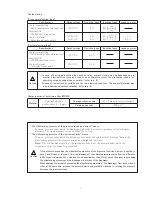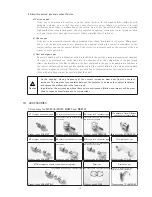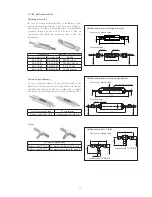
3
Pressure measuring method
Pressure receiving element
Gas to be measured
Pressure setting method
Standard installation position
Medium and ambient
temperature
Ambient humidity
Withstanding pressure
of instrument body
Withstanding pressure
of receiving element
Withstanding vibration
Withstanding impact
Insulation resistance
Withstand voltage
Material of the outer case
Applicable piping
Piping connector polarity
Cable connection
terminal screws
Mass
Accessory
Conformed standards
Caution
Measuring differential pressure
Diaphragm
(for material information, refer to “Pressure ranges and characteristics” )
Air, non-corrosive and non-combustible gases (not liquid)
Dial with scale
Installation position from upward horizontal to vertical is available (refer to p.6)
- 10 to + 50 ℃ (no freezing)
90 % RH or less (no dewing)
200 kPa
40 kPa
5 to 10 Hz Amplitude : 10 ㎜ ,
10 to 50 Hz Acceleration : 39 m/s
2
(each two hours on triaxial directions)
100 m/s
2
(each six times on triaxial direction)
Between each terminal and case 20 MΩ or more (500 V DC megger)
Between each terminal and case 1500 V AC 50 / 60 Hz, for one minute
Phenol resin and aluminum die cast
1. Vinyl, plastic or rubber tube (I.D. 6)
・・・ Piping applicable model attached with connector for vinyl or plastic tube
2. Metal tube (O.D. 6 ± 0.1)
・・・ Piping applicable model attached with connector for metal tube
3. Hard plastic tube (O.D. 6 × I.D. 4)
・・・ Inner sleeve set (XIN 6 × 4) is needed separately for type attached with piping
connector for metal tube.
The part of connector piping is marking “H” on high pressure side and “L” on low
pressure side.
M4 screws (three points)
MS65
Approximately 380 g
MS65F
Approximately 550 g
Nil
RoHS Directive (2002/95/EC)
(Products in compliance with the RoHS carry
G
or [[
G
]] mark on the label of
product itself and on each package.)
In case of measuring combustible gas and using in combustible gas area, use with
intrinsically safe apparatus construction.
:
:
:
:
:
:
:
:
:
:
:
:
:
:
:
:
:
:
:
:
:

































